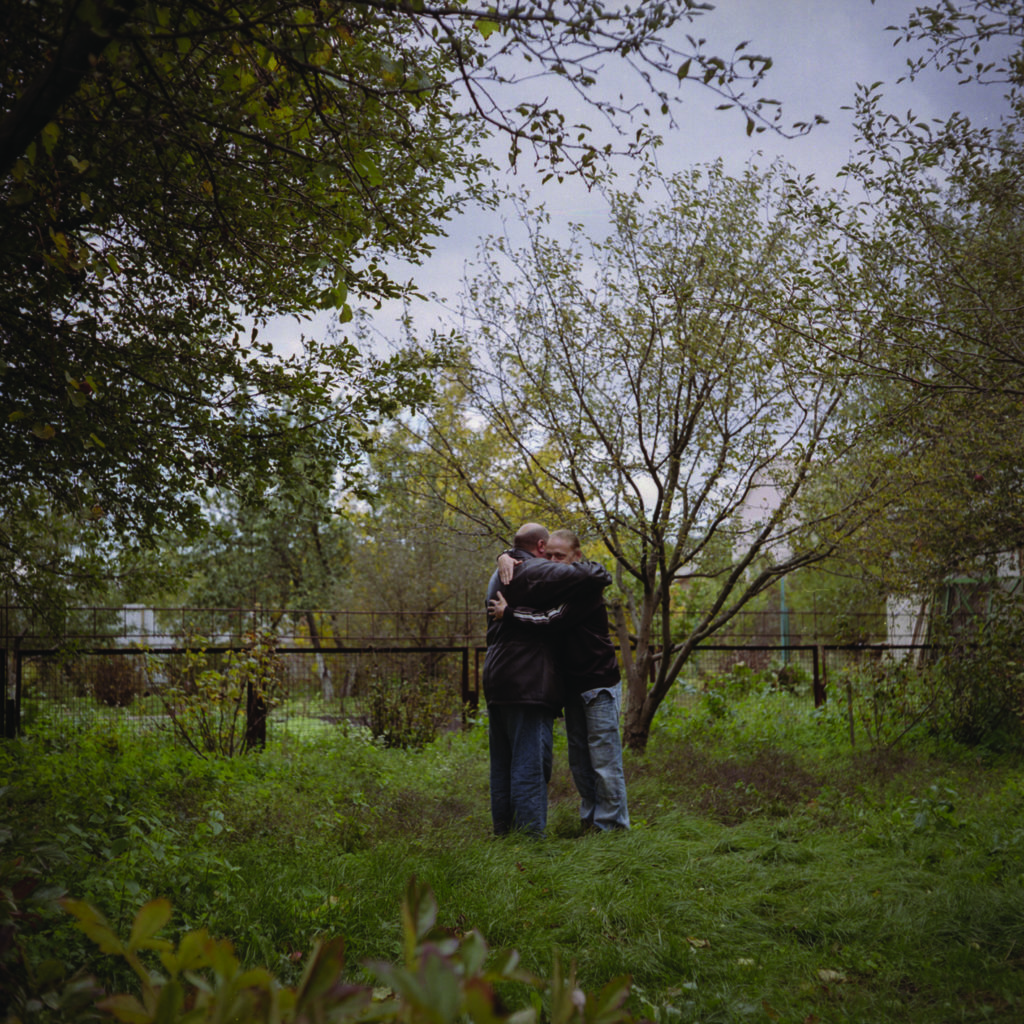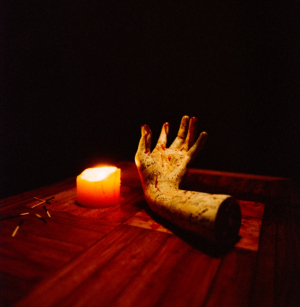Communication is commodified in A Family (Jayden Stevens, 2019). Its lonely central figure, Emerson (Pavlo Lehenkyi), holds auditions to find himself a set of parents and siblings whose paid interactions will be scripted and rehearsed before being performed for their employer. Each mundane family ‘event’ is greedily recorded by the protagonist’s bulky home-movie camera; it is clear that the process of producing a record of these interactions is of paramount importance. In fact, when the camera runs out of batteries, the entire production shuts down with immediate effect. Most of the characters remain nameless throughout, reduced to the essential signifiers of ‘mother’, ‘father’, ‘sister’ and ‘brother’, and Emerson is only interested in his scripted dialogues; any interaction beyond the scope of his constructed reality is off limits. This dynamic is eventually inverted when Ericka (Liudmyla Zamydra), the actor he has hired to play his ‘sister’, recruits him for the role of substitute ‘father’ in her own troubled family.
A Family is Stevens’ first feature-length film, and was partially subsidised by the MIFF Premiere Fund; shot in Ukraine, it is one of just two fund recipients to have been filmed outside of Australia. In its merciless skewering of the performative nature of ascribed family roles and subjection of the very idea of the family unit to an absurd, deadpan autopsy, the film skilfully presents a strange and unsettling universe wherein reality has shifted a few degrees counterclockwise. As such, it clearly owes a debt to the work of Yorgos Lanthimos, most notably the bizarre family deconstruction of 2009’s Dogtooth and the offbeat relationship dissections on show in 2015’s The Lobster (there are also nods to Maren Ade’s 2016 breakout black-comedy hit Toni Erdmann). Rather than being driven by a cynical worldview, A Family is a gleefully perverse interrogation of family relationships, one that is ultimately most concerned with the sentiment expressed in EM Forster’s novel Howards End: ‘Only connect!’[1]EM Forster, Howards End, Dover Publications, Mineola, NY, 2002 [1910], p. 133. This idea of connection was a central trope right from the beginning of the production, as Stevens explains:
The initial spark came from hearing about a guy who advertised on the US website Craigslist for someone to come to his home dressed up as an owl and watch him sleep. This touched on something unsettling for me; the loneliness and desperation that would lead someone to place such an advert intrigued me. We were especially interested in someone who paid people to act out mundane and seemingly regular situations in an attempt to build a sense of connection.[2]Jayden Stevens, quoted in ‘A Family – Q&A with Director Jayden Stevens’, Melbourne International Film Festival blog, 6 July 2009, <https://miff.com.au/blog/view/4397/a-family-ae-qa-with-director-jayden-stevens>, accessed 30 October 2020.

For Stevens, shooting the film in Ukraine provided a fascinatingly meta overlap between narrative, film form and film production. The idea of ruptured communication became a problematic parallel for the filmmaker, who doesn’t speak Ukrainian. He had to instead find a way to direct his actors via a cumbersome process of translation.
Rather than working against a cohesive vision, the language barrier only enhances the offbeat style and form that resonates throughout A Family. It reinforces the film’s tone, germinating the seeds of awkward connections and fractious relationships that play out on screen. It also lends an additional air of authenticity to the performance styles of the actors, almost all of whom are non-professional. ‘I would say something deep about the character, and the translator just wouldn’t translate,’ Stevens relates. ‘The actors didn’t know what was going on. They were like, “This is so weird.”’[3]Jayden Stevens, quoted in Karl Quinn, ‘Travellers’ Tales: Why Australian Filmmakers Increasingly Look Abroad’, The Sydney Morning Herald, 11 August 2019, <https:www.smh.com.au/entertainment/movies/we-re-a-travelliing-culture-why-australian-filmmakers-are-looking-abroad-20190809-p52fop.html>, accessed 30 October 2020.
What is transferred to the screen is that fledgling moment of translation, as the performances within the diegetic space mirror the overarching dynamic between Stevens and his actors. This magnifies the narrative tension between Emerson and his cast of family members: a director whose vision is not entirely clear to his charges directs an on-screen ‘director’ whose agenda remains mysterious to the characters played by those same actors. In this way, the performance process is turned in on itself, just as the process of creation is externalised for the camera.

Tellingly, the lens offered to the spectator collapses the ‘eyes’ of both director-figures, with Emerson’s home-movie camera offering up another point of meta-commentary. Here, the porous boundaries separating creator and creation, film process and film object, are brought into sharp relief. By self-reflexively pointing up the artificial nature of the ‘home movies’ being recorded, the off-screen director’s and on-screen director’s intentions are merged within the image. This undercuts any sense of objective reality, as the home-movie camera – customarily associated with ‘truth’ through the faithful recording of family memories – instead captures the strange staccato phrases of Emerson’s artificial family as they read the lines of dialogue he has carefully prepared for them.
Stevens’ meticulously controlled world takes place in a kind of affectless vacuum, one in which authentic dialogue and emotional connection are in short supply.
Interactions between the family members are often backwards in their methodology. In one scene, Emerson tells a stranger whom he is ‘auditioning’ for a new family-member role, ‘I want to hug in order to feel a connection of trust.’ The expression of the emotion is used as an artificial catalyst for intimacy, rather than as the customary response to warm emotions. The effect is both disquieting and darkly amusing: it is as though Emerson is imposing method-acting techniques on his unwitting participants, actively eschewing any semblance of interpersonal boundaries. The bleak colour palette of the Ukrainian setting is also mined for its foreignness; at the same time, it seems to speak to Emerson’s desolate emotional interior. It’s important to point out that A Family does not set out to provide an authentic representation of life in Ukraine – as Stevens explains, the film is ‘a showcase of the bizarre and the unfamiliar’.[4]Stevens, quoted in ‘A Family – Q&A’, op. cit.

This sensibility is transcribed to the domestic space. In one sequence, an exterior medium long shot reinforces the displaced relations between Emerson and his surrogate family unit. Rather than a conventional establishing shot that would have us peering through a window at the activity within, instead we are outside with the family members, who stand far beneath the window’s inviting glow. They are formally disconnected from the convivial connotations of hearth and home signalled by a lamp behind the window. Tellingly, only a mean little pool of cold light touches the edges of the darkness that enfolds them. The family members are arranged in a queue, as if lining up at a food bank or Centrelink office. At the head of the queue stands Emerson, who hands each one in turn payment for their work. The framing and mise en scène defamiliarise the image of ‘home’ so that the window is slightly askew and covered by bars, ‘locking out’ the humans from the security of belonging to a place, or to one another. The cracked and peeling walls evoke an untenanted emotional space, while the sound of a dog interminably barking suggests the claustrophobia of suburbia. This aural disjuncture perhaps underscores Emerson’s incoherent ideas about family life, collected from repeated exposure to television shows. The static camera watches on, its dispassionate gaze only adding to the melancholy atmosphere.
Stevens’ meticulously controlled world takes place in a kind of affectless vacuum, one in which authentic dialogue and emotional connection are in short supply. External signifiers or anchor points are almost entirely absent. Throughout the film, the home-movie camera becomes a self-reflexive trope as the narrative nods to the characters’ shared reliance on television for entertainment, security and comfort. When the interview process is flipped and Emerson becomes the interrogated – as a prospective replacement for Ericka’s father, and thus also the husband of her single mother, Christina (Tetiana Kosianchuk) – he is questioned about family activities. During the interview, Ericka asks Emerson what his ‘favourite thing to do’ with his new family is; upon receiving a vague answer from him, she declares, ‘We like watching TV.’

In A Family, a question eventually presents itself: what if your only social reference points were extracted from television? The film’s bizarre logic magnifies this idea until the act of recording family rituals like Christmas Day only take on meaning when they are carefully constructed and filmed, validated by the ‘proof’ of the image. By extension, relationships are valorised when they can be replayed as a sequence of actions and interactions, as in a sitcom or even a soap opera. Although never explicitly referenced, there is a sense that the spectres of American sitcoms linger around the edges of the frame, conspiratorial and reproachful.
For socially isolated characters like Emerson, who have perhaps gleaned most of what they know about the world from television, those endless processions of picture-perfect families have been perversely replicated until they become a parody of their original saccharine representations. A Family removes the social aspects of behaviour and reduces interactions to blunt expressions of desires, needs or intentions. There is much dark humour generated from the uncomfortable spaces between customary social behaviour and behaviour that doesn’t follow the rules. For instance, when Christina dispassionately points out her physical assets to Emerson and Ericka protests, the matriarch rebukes her: ‘It’s nothing to be ashamed of. Your father loved my bosoms. He would fondle them often. He called them his “woman cushion” and would fall asleep snuggled between them – like a puppy hiding from a storm.’ The lack of social veneer in the film is reinforced by Stevens’ stylised, front-on framing and use of muted lighting. The composition eschews naturalism, perfectly complementing the offbeat dialogue and painfully stilted exchanges. That dark undercurrent of melancholy finally breaks the surface as we watch mother and daughter attempt to reconstruct the minutiae of their former family life with a replacement father-figure (who is forced to wear a wig so that he might better resemble his predecessor).
A series of tableaux convey the ritualistic nature of family behaviours, from teeth brushing to birthday parties to family portraits. The family photograph is a particularly strange reconstruction, whereby the new iteration of the family with its father/husband-figure restored is snapped with a picture of the crucified Jesus held aloft. In these darkly amusing set pieces, a strange poignancy occasionally punctures the frame. The futility of Christina’s and Ericka’s attempts to resurrect a husband and father is made painfully clear. There is sadness in the nostalgic desire to ‘return’ to a moment in the past that has been lost forever. It is perhaps here that A Family’s absurd tenor finds its most powerful expression.
https://www.afamilythefilm.com/
Endnotes
| 1 | EM Forster, Howards End, Dover Publications, Mineola, NY, 2002 [1910], p. 133. |
|---|---|
| 2 | Jayden Stevens, quoted in ‘A Family – Q&A with Director Jayden Stevens’, Melbourne International Film Festival blog, 6 July 2009, <https://miff.com.au/blog/view/4397/a-family-ae-qa-with-director-jayden-stevens>, accessed 30 October 2020. |
| 3 | Jayden Stevens, quoted in Karl Quinn, ‘Travellers’ Tales: Why Australian Filmmakers Increasingly Look Abroad’, The Sydney Morning Herald, 11 August 2019, <https:www.smh.com.au/entertainment/movies/we-re-a-travelliing-culture-why-australian-filmmakers-are-looking-abroad-20190809-p52fop.html>, accessed 30 October 2020. |
| 4 | Stevens, quoted in ‘A Family – Q&A’, op. cit. |





